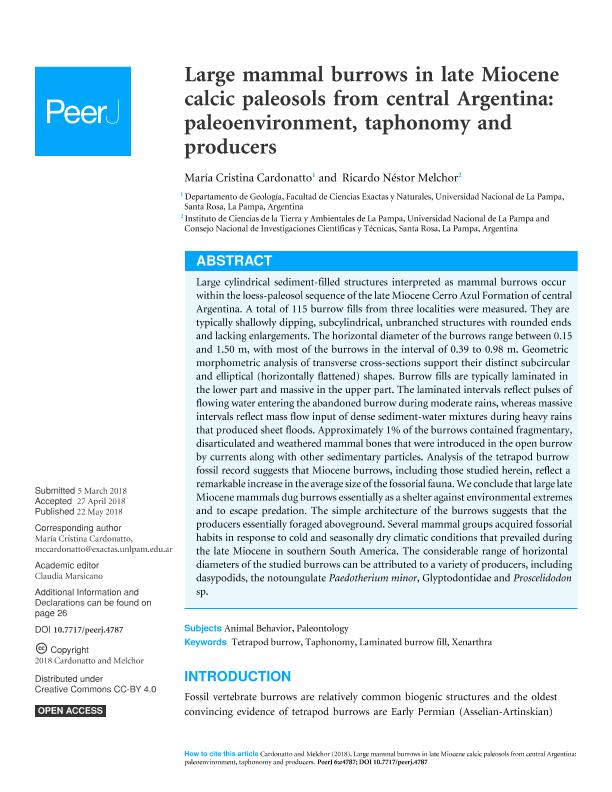Mostrar el registro sencillo del ítem
dc.contributor.author
Cardonatto, María Cristina

dc.contributor.author
Melchor, Ricardo Nestor

dc.date.available
2019-08-12T19:53:30Z
dc.date.issued
2018-05
dc.identifier.citation
Cardonatto, María Cristina; Melchor, Ricardo Nestor; Large mammal burrows in late Miocene calcic paleosols from central Argentina: Paleoenvironment, taphonomy and producers; PeerJ Inc.; PeerJ; 2018; 5; 5-2018; 1-36
dc.identifier.issn
2167-8359
dc.identifier.uri
http://hdl.handle.net/11336/81500
dc.description.abstract
Large cylindrical sediment-filled structures interpreted as mammal burrows occur within the loess-paleosol sequence of the late Miocene Cerro Azul Formation of central Argentina. A total of 115 burrow fills from three localities were measured. They are typically shallowly dipping, subcylindrical, unbranched structures with rounded ends and lacking enlargements. The horizontal diameter of the burrows range between 0.15 and 1.50 m, with most of the burrows in the interval of 0.39 to 0.98 m. Geometric morphometric analysis of transverse cross-sections support their distinct subcircular and elliptical (horizontally flattened) shapes. Burrow fills are typically laminated in the lower part and massive in the upper part. The laminated intervals reflect pulses of flowing water entering the abandoned burrow during moderate rains, whereas massive intervals reflect mass flow input of dense sediment-water mixtures during heavy rains that produced sheet floods. Approximately 1% of the burrows contained fragmentary, disarticulated and weathered mammal bones that were introduced in the open burrow by currents along with other sedimentary particles. Analysis of the tetrapod burrow fossil record suggests that Miocene burrows, including those studied herein, reflect a remarkable increase in the average size of the fossorial fauna. Weconclude that large late Miocene mammals dug burrows essentially as a shelter against environmental extremes and to escape predation. The simple architecture of the burrows suggests that the producers essentially foraged aboveground. Several mammal groups acquired fossorial habits in response to cold and seasonally dry climatic conditions that prevailed during the late Miocene in southern South America. The considerable range of horizontal diameters of the studied burrows can be attributed to a variety of producers, including dasypodids, the notoungulate Paedotherium minor, Glyptodontidae and Proscelidodon sp.
dc.format
application/pdf
dc.language.iso
eng
dc.publisher
PeerJ Inc.
dc.rights
info:eu-repo/semantics/openAccess
dc.rights.uri
https://creativecommons.org/licenses/by-nc-sa/2.5/ar/
dc.subject
Laminated Burrow Fill
dc.subject
Taphonomy
dc.subject
Tetrapod Burrow
dc.subject
Xenarthra
dc.subject.classification
Paleontología

dc.subject.classification
Ciencias de la Tierra y relacionadas con el Medio Ambiente

dc.subject.classification
CIENCIAS NATURALES Y EXACTAS

dc.title
Large mammal burrows in late Miocene calcic paleosols from central Argentina: Paleoenvironment, taphonomy and producers
dc.type
info:eu-repo/semantics/article
dc.type
info:ar-repo/semantics/artículo
dc.type
info:eu-repo/semantics/publishedVersion
dc.date.updated
2019-08-09T14:33:00Z
dc.journal.volume
2018
dc.journal.number
5
dc.journal.pagination
1-36
dc.journal.pais
Estados Unidos

dc.description.fil
Fil: Cardonatto, María Cristina. Consejo Nacional de Investigaciones Científicas y Técnicas; Argentina. Universidad Nacional de La Pampa. Facultad de Ciencias Exactas y Naturales. Departamento de Geología; Argentina
dc.description.fil
Fil: Melchor, Ricardo Nestor. Consejo Nacional de Investigaciones Científicas y Técnicas. Instituto de Ciencias de la Tierra y Ambientales de La Pampa. Universidad Nacional de La Pampa. Facultad de Ciencias Exactas y Naturales. Instituto de Ciencias de la Tierra y Ambientales de La Pampa; Argentina
dc.journal.title
PeerJ
dc.relation.alternativeid
info:eu-repo/semantics/altIdentifier/url/https://peerj.com/articles/4787/
dc.relation.alternativeid
info:eu-repo/semantics/altIdentifier/doi/https://doi.org/10.7717/peerj.4787
Archivos asociados
